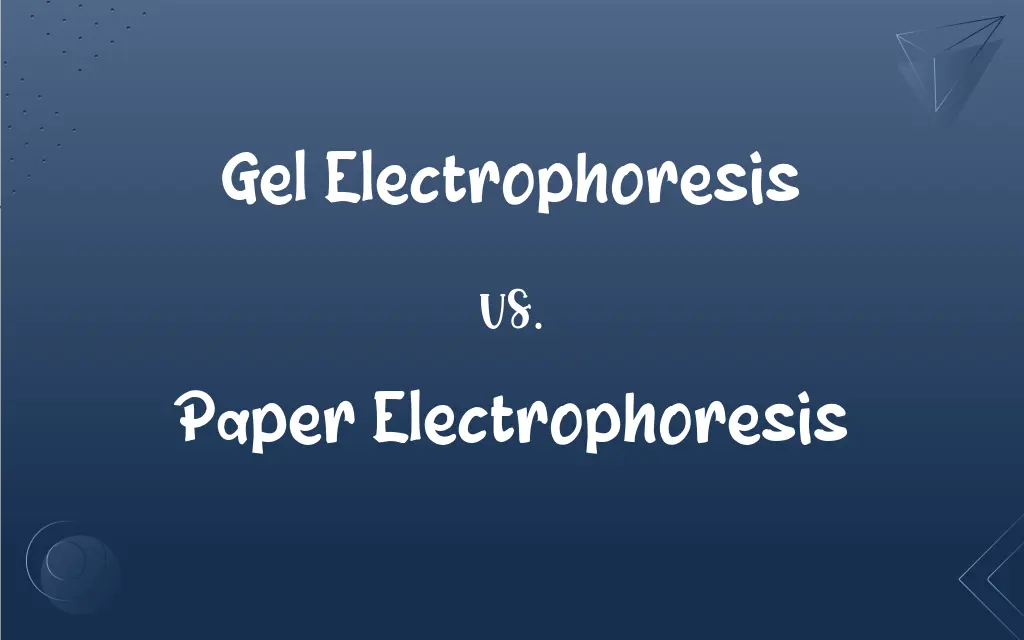Gel Electrophoresis vs. Paper Electrophoresis: What's the Difference?
Edited by Aimie Carlson || By Janet White || Published on March 3, 2024
Gel electrophoresis separates molecules using a gel matrix, while paper electrophoresis uses a paper strip as the medium.

Key Differences
Gel electrophoresis is a laboratory method used to separate mixtures of DNA, RNA, or proteins based on their size and charge by passing them through a gel matrix. Paper electrophoresis, on the other hand, involves the separation of charged molecules using a strip of absorbent paper as the medium.
In gel electrophoresis, the gel matrix often consists of agarose or polyacrylamide, providing a porous network through which molecules can move. Paper electrophoresis uses paper as a stationary phase, where the movement of molecules occurs along the moist surface of the paper.
The separation mechanism in gel electrophoresis relies on the sieving effect of the gel matrix, where smaller molecules move faster than larger ones. In contrast, paper electrophoresis separation is based more on the capillary action of the paper and the charge-to-mass ratio of the molecules.
Gel electrophoresis is widely used for the analysis and purification of nucleic acids and proteins, offering high resolution and the ability to handle complex samples. Paper electrophoresis, though less commonly used today, was pivotal in the early days of biochemistry for separating small molecules like amino acids and peptides.
Gel electrophoresis allows for a variety of staining and detection methods post-separation, including ethidium bromide for DNA and Coomassie blue for proteins. Paper electrophoresis, being simpler and less sensitive, often requires more specialized staining techniques to visualize the separated components.
ADVERTISEMENT
Comparison Chart
Medium
Gel matrix (agarose or polyacrylamide)
Absorbent paper
Separation Mechanism
Sieving effect based on size and charge
Capillary action and charge-to-mass ratio
Common Uses
DNA, RNA, and protein analysis
Early biochemical analyses of small molecules
Resolution
High resolution and capacity for complex samples
Lower resolution, best suited for simpler mixtures
Detection Methods
Various staining techniques (e.g., ethidium bromide, Coomassie blue)
Requires specialized staining for visualization
ADVERTISEMENT
Gel Electrophoresis and Paper Electrophoresis Definitions
Gel Electrophoresis
Used to separate nucleic acids and proteins.
Gel electrophoresis helped us separate the protein samples.
Paper Electrophoresis
A method for separating charged molecules on paper.
Paper electrophoresis was used to separate the amino acids.
Gel Electrophoresis
A technique for molecule separation in a gel matrix.
We used gel electrophoresis to analyze the DNA fragments.
Paper Electrophoresis
Utilizes absorbent paper as the medium.
We placed the sample on the strip for paper electrophoresis.
Gel Electrophoresis
Involves an electric field across a gel.
Applying an electric field in gel electrophoresis moves molecules through the gel.
Paper Electrophoresis
Requires staining for detection of separated entities.
After paper electrophoresis, we used a specific dye to visualize the results.
Gel Electrophoresis
Distinguishes molecules by size and charge.
Gel electrophoresis sorted the molecules by size.
Paper Electrophoresis
Separates substances based on mobility in an electric field.
The electric field in paper electrophoresis caused the molecules to migrate.
Gel Electrophoresis
Allows for visualization of separated components.
After gel electrophoresis, we stained the gel to see the bands.
Paper Electrophoresis
Often used for simple biochemical separations.
Paper electrophoresis is good for analyzing small molecules.
FAQs
What is gel electrophoresis?
Gel electrophoresis is a method to separate molecules in a gel matrix using an electric field.
What is the main advantage of gel electrophoresis over paper electrophoresis?
Gel electrophoresis offers higher resolution and is more versatile for different types of samples.
How are the results of gel electrophoresis visualized?
Results of gel electrophoresis are visualized using various staining methods depending on the molecules.
How does paper electrophoresis work?
Paper electrophoresis involves separating molecules on a paper strip by applying an electric field.
What is the main use of paper electrophoresis today?
Paper electrophoresis is primarily used for educational purposes and simple biochemical separations.
What factors affect molecule migration in paper electrophoresis?
Molecule migration in paper electrophoresis is affected by the molecule's charge, size, and the paper's capillary action.
What types of samples can be analyzed by gel electrophoresis?
Gel electrophoresis is suitable for analyzing DNA, RNA, and proteins.
Is paper electrophoresis still widely used?
Paper electrophoresis is less common now, replaced by more advanced techniques like gel electrophoresis.
Can gel electrophoresis separate large molecules?
Yes, gel electrophoresis can separate large molecules, with the resolution depending on the gel composition.
How can the resolution of gel electrophoresis be improved?
Resolution can be improved by optimizing gel concentration, voltage, and running time.
How does the buffer affect gel electrophoresis?
The buffer ensures conductivity and maintains pH, affecting molecule migration and separation.
Can both DNA and proteins be separated on the same gel?
It's possible but uncommon, as optimal conditions for DNA and protein separation differ significantly.
How do you choose between gel and paper electrophoresis for an experiment?
The choice depends on the sample complexity, required resolution, and available equipment.
What type of gel is used for protein electrophoresis?
Polyacrylamide gels are commonly used for protein electrophoresis due to their fine pore size.
What are the environmental considerations for disposing of gels and buffers?
Disposal should follow safety guidelines, especially for toxic substances like ethidium bromide.
What safety precautions are necessary for gel electrophoresis?
Safety precautions include wearing gloves, goggles, and handling ethidium bromide, if used, with care.
How does the electric field influence gel electrophoresis?
The electric field causes charged molecules to migrate through the gel, separating them based on size and charge.
Why is agarose commonly used in gel electrophoresis for DNA?
Agarose provides an appropriate matrix for separating DNA fragments by size due to its pore structure.
What are the limitations of paper electrophoresis?
Paper electrophoresis has limitations in resolution and sensitivity compared to gel-based methods.
Can gel electrophoresis be used for quantitative analysis?
Yes, with proper standards and calibration, gel electrophoresis can be used for quantitative analysis.
About Author
Written by
Janet WhiteJanet White has been an esteemed writer and blogger for Difference Wiki. Holding a Master's degree in Science and Medical Journalism from the prestigious Boston University, she has consistently demonstrated her expertise and passion for her field. When she's not immersed in her work, Janet relishes her time exercising, delving into a good book, and cherishing moments with friends and family.
Edited by
Aimie CarlsonAimie Carlson, holding a master's degree in English literature, is a fervent English language enthusiast. She lends her writing talents to Difference Wiki, a prominent website that specializes in comparisons, offering readers insightful analyses that both captivate and inform.































































